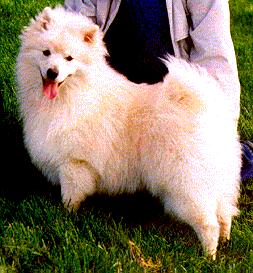
Nederlan Herman V Mack
 Nederlan Herman V Mack |
ORIGIN: Germany
PURPOSE: Watch and Companion Dog
CLASSIFICATION F.C.I.
Group 5 - Spitz and primitive types
Section 4 - European Spitz
Without working trial.
BRIEF HISTORICAL SUMMARY
German Spitz are descendants of the
stone age "Peat Dogs" (Torfhund) "Canis familiaris palustris
Ruthimeyer", and the later Lake Dweller's (Pfahlbau) Spitz;
they are the oldest breed of dog in Central Europe. Numerous
other breeds have been produced from them. In non-German
speaking countries Wolfsspitz are known as Keeshonds; and
Toy Spitz, as Pomeranians.
GENERAL APPEARANCE
Spitz breeds are captivating on account of their beautiful
coats, made to stand off by plentiful undercoat. Particularly
impressive is the strong, mane-like collar around the neck (ruff)
and the bushy tail carried boldly over the back. The foxy head
with alert eyes and the small pointed, closely set ears give
the Spitz his unique characteristic, and cheeky appearance.
Important Proportions: the ration of height (at withers) to body length is 1:1
Behaviour and character: The German Spitz is always attentive, lively and exceptionally devoted to his owner. He is very teachable and easy to train. His distrust of strangers and lack of hunting instinct make him the ideal watchdog for home and farm. He is neither timid nor aggressive, Indifference to weather, robustness and longevity are his most outstanding attributes.
HEAD
Cranial region
The Spitz's medium size head, seen from above,
appears broadest at the back and tapers in wedge shape to the
tip of the nose.
Stop: Moderate to marked, never abrupt.
Facial region
BODY
TAIL
The tail is set on high and of medium length. It reaches
upwards and rolls forward over the back, straight from the root. It
lies firmly over the back and is covered with very bushy hair. A double
curl at tip of tail is tolerated.
LIMBS
Forequarters
Hindquarters
GAIT/MOVEMENT: The German Spitz moves straight ahead with good drive, fluid and springy.
SKIN: The skin covers the body tightly without any wrinkles.
COAT
Hair:The German Spitz has a double coat: Long, straight, stand-off,
top coat and short, thick, cottony, wool-like undercoat. Head, ears,
front side of front and hind legs and the feet are covered by short,
thick (velvety) hair. The rest of the body has a long rich coat.
Not wavy, curly or corded, not parted on the back. Neck and shoulders
are covered by a thick mane. The backside of the front legs is well
feathered. The hind legs have ample feathering from croup to hocks.
The tail is bushy.
 Keewest's Ivory Princess  Darkenwald's Orange Crush
|
Black Spitz: In the black Spitz, the undercoat and skin must also be
black and the colour on the top must be a shining black without any
white or other markings.
Brown Spitz: The brown Spitz should be uniformly dark brown.
White Spitz: The coat should be pure white without any trace of
yellow, which often occurs, especially on the ears.
Orange Spitz: The orange Spitz should be evenly coloured in
the medium colour range.
Grey-shaded Spitz (Keeshond): Grey-shaded is a silver grey with
black hair-tips. Muzzle and ears dark in colour; around the eyes - well
defined "spectacles", shown as a delicately penciled black line slanting
from outer corner of eye to lower corner of ear, coupled with distinct
markings and shading forming expressive short eyebrow; mane and ring on
shoulder lighter; forelegs and hindlegs - without any black marking under the
elbows or stifles, except slight penciling on the toes; black tip of tail;
underside of tail and trousers pale silver grey.
Other coloured Spitz: the term "other colours" covers all shades of
colour, such as: cream, cream-sable, orange-sable, black and tan; and
parti-colour (with white always as main colour.) The black, brown, grey or
orange patches must be distributed over the whole body.
SIZE (1" = 2.54 cm)
Height at the withers:
WEIGHT
Each variety of German Spitz should have a weight corresponding
to its size.
FAULTS
Any departure from the foregoing points should be considered a
fault and the seriousness with which the fault should be regarded should be
in exact proportion to its degree.
Serious faults
· Faults in construction.
· Head too flat; distinct apple head.
· Flesh-coloured nose, eyelids and lips.
· In Wolfspitz/Keeshond, Giant Spitz and Medium-size Spitz - missing teeth.
· Faults in movement.
· In grey-shaded Spitz - missing of distinct markings of the face.
Eliminating faults
· Gap in fontanel.
· Overshot or undershot bite.
· Ectropion or entropion.
· Semi-pricked ears.
· Definite white patches in all non-white Spitz.
Note - Male animals should have two apparently normal testicles fully descended into the scrotum.
Home | FAQ | About Us | News | Our dogs | Ancestors | Puppies | Older dogs | Fun | Genetics | Articles | Links | Contact | Site map |